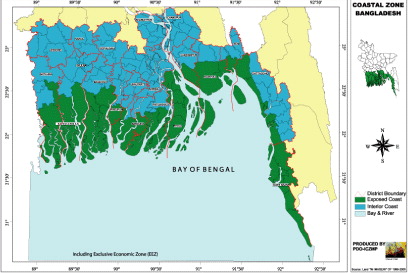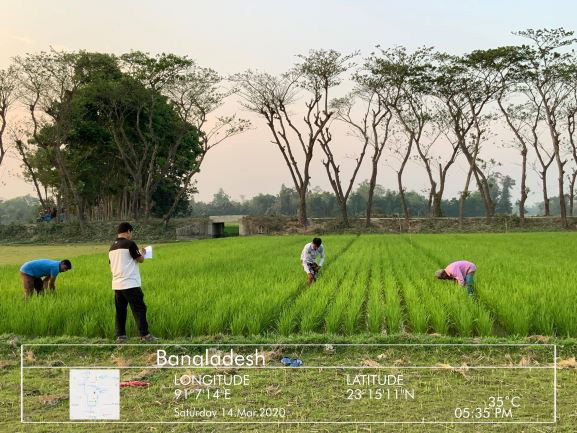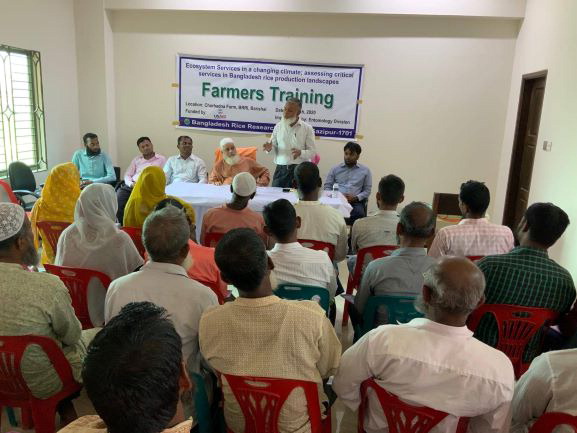Cycle 6 (2017 Deadline)
Ecosystem services in a changing climate: assessing critical services in Bangladesh rice production landscapes
PI: Md Panna Ali, panna_ali@yahoo.com, Bangladesh Rice Research Institute (BRRI)
U.S. Partner: Douglas A. Landis, Michigan State University
Project dates: December 2017 - October 2021
Project Overview:
Rice contributes more than 80% of the total food supply in Bangladesh, including 76% of daily caloric intake and 66% of total protein requirements (Brolley 2015; Bhuiyan et al. 2002). The coastal region of Bangladesh, which covers 20% of the country and more than 30% of the cultivable land and contributes 16% of the total rice production, is the most vulnerable region to climate change (Minar et al. 2013). Moreover, due to increasingly variable rainfall leading to a reduction in freshwater flows, about 53% of the coastal areas are experiencing salinity intrusions that restrict crop production (Rahman 2012). As a consequence, rice productivity in this area is 70% lower than the national average. In this project, Dr. Ali and his colleagues will quantify the potential impacts of changing conditions on ecosystem services by quantitatively determining the impact of climate variability on the provision of four key ecosystem services: carbon sequestration, pest suppression, water supply, and rice production. They will use spatially explicit models to project future patterns of terrestrial ecosystems and the production and values of ecosystem services. The scientific understanding of the links between climate, ecosystems, and economic value is still unknown or poorly developed for Bangladesh. Therefore, this collaborative research effort involving U.S. experts focused on developing models and estimating the impacts of changing conditions on ecosystem services in Bangladesh will be an important tool for reversing current and future losses in the economic value of Bangladesh’s natural ecosystems.
The area where the project will be conducted is characterized by lower rice productivity due to limited ecosystem services. Therefore, identification of the ecosystem services that induce lower rice production and those that are predicted to be most vulnerable to environmental change in the future is a critical component of enhancing productivity in the region. In this project, the research team will analyze environmental impacts on crop production systems and suggest appropriate coping strategies and adaptation options for improving coastal agriculture, both for increased agricultural production and for better livelihoods for the vulnerable farming community. As a whole, this project will not only provide the scientific community with evidence to overcome anecdotal information, a hindrance to effective ecosystem service monitoring and management, but also aid sustainable ecosystem management implementation and policy interventions.
Final Summary of Project Activities
In the course of the project, the PEER team investigated the effect of climate change on rice yield in Bangladesh. In order to create an adaptation plan it was important to understand the spatial and temporal variability in crop yield. For this purpose, this PEER project explored nearly 50 years of rice yield data within Bangladesh, which provided an opportunity to explore the trajectory of yield changes as well as the drivers of yield anomalies. Based on research findings, at the national and regional level, the PI reported, that there are clear increases in yield over time for all three types of rice (Aus, Aman, and Boro) in all regional administrative areas. The steady increase is a result of improved genetics (e.g. disease resistance) and the introduction of new agronomic practices (e.g. improved access to fertilizer).
The team also worked on predicting carbon stock in soil at coastal areas of Bangladesh using multilayer perceptron (MLP). To model the effect of salinity on soil organic carbon stock in soil, and PEER project built a two-layer feedforward network (multilayer perceptron, MLP) with sigmoid activation function and linear output neurons (fitnet). The findings indicated that bulk density, soil organic carbon, carbon stock in soil are associated with salinity. Model built using salinity as the predictor variable showed strong power to predict these three variables. The salinity content significantly affected the carbon stock in soil in coastal areas of Bangladesh and soil carbon stock in rice production landscape decreased with increasing levels of salinity. The model built using salinity as the predictor variable was effective un predicting these three variables.
Climate change adaptation perception of smallholder rice farmers in climate susceptible areas was also studied by the PEER team as part of this project. More than 80% farmers perceived that salinity and scarcity of fresh water irrigation is the main problem to grow rice in their land at coastal areas. A high proportion of farmers (95%) perceived the reproductive (e.g. booting, heading, and flowering) stages of the rice plant as the most sensitive to salinity problems. Salinity was measured in the farmer fields and was used in rice production modeling interpretations. Most of the farmers (70%) were undertaking early transplanting and applying irrigation in order to adapt to salinity problems which occur during later stages of rice crop growth during Boro season. Similar results we observed in the PEER team's experimental plots. This experiment was also conducted jointly with the participating farmers. Farmers' perceptions of salinization and measures to manage salinity need to be considered in research prioritization and policy formulation by the government. This action could potentially secure rice production and thus contribute to the achievement of Sustainable Development Goals (SDG-1, 2 and 3).
This PEER project also investigated the effect of landscape composition and configuration on natural enemies, herbivore suppression and rice yield at multiple spatial scales in two rice producing regions of Bangladesh. Landscape heterogeneity effects on pest abundance were observed at all scales and were most pronounced at the 1000 m scale for all natural enemies combined and at smaller spatial scales for ladybird beetles (500 m), and spiders (200 m) individually. Ladybird beetles were positively influenced by the rainfall, roads, and fallow land, while spiders were strongly influenced by rice phenology. The proportion of water-bodies and specially of natural habitat had low weight in statistical models but, high proportion of natural habitat together with fallow land was associated with increased abundances of natural enemies, while the coincidence of rice and urban areas in the landscape was associated with decreased numbers. Natural enemies also responded to rice landscape configuration and declined with increasing patch cohesion and aggregation, while increasing with increasing edge density suggesting that finer grained rice landscapes are better suited to rice pest suppression. In all the cases, water-bodies and the proportion of natural habitat had low weight in the models. On the other hand, contour plots showed that high proportion of NH and fallow land was associated with high abundances of NE while the coincidence of rice and urban areas in the landscape was associated with decreased NE abundances. These results suggest that promoting fallow lands and edges between growing rice patches along with decreasing the prophylactic use of insecticides can lead to more sustainable insect pest management in rice.
At the conclusion of the project, the PEER team reported that landscape diversity is one of the key drivers for maintaining ecosystem services in agricultural production. This study indicates that landscape diversity plays a vital role to shape the species diversity in rice field, providing guidelines for considering the local landscape approach to plan for conservation of arthropod diversity for maximizing ecosystem service in crop production. For purposes of assessing climate change adaptation, sixty farmers' fields were selected to conduct field trial of climate change adaptation practice for rice production in Satkhira and Khulna districts. Rice seedlings were transplanted in 60 plots at three different transplanting dates. This PEER project identified that early transplanting of rice (i.e. farmers are advised to transplant rice before January) in in saline soil would be the best option to avoid salinity at crop vulnerable stage. Early transplanting date enhanced crop yield in coastal areas of Bangladesh. Sixty rice growers were trained for rice production in climate susceptible area, impact of climate change on ecosystem services in Bangladesh. These trainings were conducted in Cox's Bazar. PEER training enhanced the knowledge of rice farmers on climate change and sustainable rice production in saline areas. Potential development impacts
In the course of the training conducted through the PEER project, 60 smallholder farmers received information and knowledge on improved farming technologies, practices and climate change mitigation process in crop field. In addition, the project team demonstrated the performance of BRRI-released rice varieties over the local varieties in 60 farmers field. Thus, the project proved that growing BRRI released high yielding rice varieties in the field will increase food production per unit area. This will help improve food security, farm income, and livelihood resilience. Publications
Ali, M. P., Biswas, M., Clemente-Orta, G., Kabir, M. M. M., Datta, J., Haque, S. S., Qin, X., Landis, D., Kaur, P., Pittendrigh, B. R., & Howlader, M. T. H. (2022). Landscape diversity influences the arthropod species diversity in the rice field. Frontiers in Environmental Science, 10. https://doi.org/10.3389/fenvs.2022.740287 Ali, M.P., Clemente-Orta, G., Kabir, M.M.M. et al. Landscape structure influences natural pest suppression in a rice agroecosystem. Sci Rep 13, 15726 (2023). https://doi.org/10.1038/s41598-023-41786-yAli, M. P., et al. "Farmer's behavior in pesticide use: Insights study from smallholder and intensive agricultural farms in Bangladesh." Science of The Total Environment, vol. 747, 2020, article 141160. ISSN 0048-9697, https://doi.org/10.1016/j.scitotenv.2020.141160
Ali, M.P., Kabir, M.M.M., Haque, S.S. et al. Surrounding landscape influences the abundance of insect predators in rice field. BMC Zool 5, 8 (2020). https://doi.org/10.1186/s40850-020-00059-1
Ali, M. P., Rahman, M. S., Nowrin, F., Haque, S. S., Qin, X., Haque, M. A., Uddin, M. M., Landis, D. A., & Howlader, M. T. H. (2021). Salinity Influences Plant–Pest–Predator Tritrophic Interactions. Journal of Economic Entomology, 114(4), 1470–1479. https://doi.org/10.1093/jee/toab1
|







